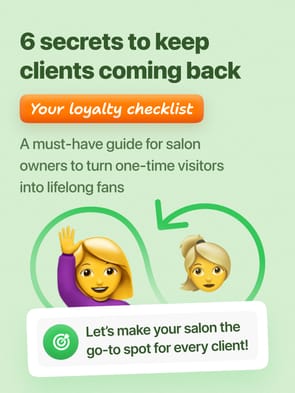How to create a more inclusive beauty salon
Inclusivity is no longer a trend in the beauty industry; it's a fundamental business imperative. Clients today seek experiences that reflect their diverse identities and values, and salons that fail to create welcoming and inclusive environments risk losing market share and damaging their reputation.
This article lays out actionable steps to create an inclusive salon.
What is salon inclusivity and why it's important
Beyond legal compliance, inclusivity is a strategic advantage for salons. It fosters a welcoming atmosphere, attracts a wider client base, and strengthens your brand reputation. Here's a breakdown of what inclusivity means and why you should think about “how to create an inclusive salon”.
What is salon inclusivity?
- Going beyond non-discrimination: it's actively celebrating diverse beauty standards and needs.
- Welcoming all clients: regardless of age, race, gender identity, ability, or other characteristics.
- Creating a safe space: free from bias, prejudice, and microaggressions.
Create a thriving nail salon!
Dream of a booming nail salon? Our nail salon business plan delivers expert strategies to build a profitable business from the ground up. Download now — make your vision a reality!
Oh no! We couldn’t subscribe you ☹️
Done! We've sent a link to your Email 📨
The business case for salon inclusivity
While creating a welcoming environment for all is ethically essential, inclusivity in salons goes beyond a moral obligation; it's a smart business decision. Here's why:
- Expanding your client base: the beauty industry traditionally caters to specific demographics. By embracing inclusivity, you open your doors to a broader market.
- Competitive advantage: in a saturated market, differentiation is key. Inclusivity sets you apart as a progressive, forward-thinking salon that resonates with contemporary values. This attracts clients who actively seek diverse and welcoming businesses.
- Brand reputation and positive PR: your commitment to inclusivity becomes a powerful marketing tool. Positive word-of-mouth, online reviews, and community engagement build a strong brand reputation that attracts new clients and reinforces your values.
- Employee morale and retention: fostering a diverse and inclusive work environment fosters better teamwork, communication, and creativity. Engaged employees provide superior customer service and are more likely to stay with your company, reducing staff turnover costs.
- Reduced legal risk: non-discrimination laws are clear, and inclusivity helps you avoid costly lawsuits and legal fees.
But inclusivity isn't just about avoiding negatives; it's about:
- Innovation: catering to diverse needs can inspire new service offerings and product lines, expanding your revenue streams.
- Authenticity: by genuinely embracing inclusivity, you create a transparent and authentic brand that resonates with clients seeking genuine connections.
- Community building: partnering with diverse organizations and individuals strengthens your community ties, increasing local support and engagement.
Remember, inclusivity is an ongoing journey, not a destination. By consistently evaluating and refining your approach, you'll not only create an inclusive salon that is a welcoming space for all but also unlock the true potential of your business.
Practical steps for business growth or how to create inclusive salon
Attracting and retaining a diverse clientele requires deliberate action, ensuring everyone feels welcome and valued. Here's your actionable roadmap:
Educate your staff
Creating a truly inclusive salon starts from the inside out. Your staff are the frontline representatives, shaping every client's experience. That's why investing in comprehensive diversity and inclusion (D&I) training is non-negotiable. It's not just about avoiding discrimination; it's about fostering a culture of understanding, respect, and genuine connection with clients from all walks of life.
Effective D&I education delves deeper, building cultural competency. This means equipping your staff to understand and appreciate diverse backgrounds, including:
- Understanding LGBTQIA+ identities and terminology
- Navigating religious and cultural hair practices
- Recognizing and addressing unconscious bias
Here are some D&I courses by Stanford, Cornell and Coursera.
Remember, D&I training isn't just about ticking boxes. It's about fostering empathy and a genuine desire to serve all clients with respect. Encourage staff to:
- Actively listen to client needs and preferences.
- Ask open-ended questions to avoid assumptions.
- Celebrate differences and create a welcoming environment for everyone
Investing in your staff's D&I education isn't just the right thing to do; it's a strategic investment in your salon's future. By fostering a culture of inclusivity, you'll attract new clients, retain existing ones, and create salon diversity — a positive, thriving environment for your entire team.
Provide accessibility and accommodations
“To create inclusive salon” means not just welcoming diverse identities, but actively ensuring everyone feels physically and emotionally comfortable during their visit. Here's how to move beyond basic accessibility to create a truly accommodating experience:
Physical modifications:
- Wheelchair accessibility: ramps, accessible restrooms, and wider doorways are essential. Consider automatic door openers for ease of entry.
- Height-adjustable chairs: invest in chairs that cater to a range of heights and physical abilities.
- Mobile equipment: have portable styling stations or shampoo bowls for clients who may prefer not to transfer from their wheelchairs.
Sensory sensitivities:
- Offer low-noise areas: create a designated quiet space for clients who might feel overwhelmed by the typical salon buzz.
- Scent-free options: minimize strong fragrances, such as perfumes or scented products, and offer fragrance-free alternatives.
- Adjustable lighting: implement dimmer switches or offer portable lamps for clients sensitive to bright lights.
Beyond the basics:
- Visual aids: provide large-print menus and signage for clients with visual impairments.
- Communication options: train staff in alternative communication methods for clients who may have hearing difficulties or speech impediments.
- Service animals: welcome service animals and be prepared to accommodate their needs discreetly.
Creating an accessible salon isn't just about meeting legal requirements; it's about demonstrating genuine care and inclusivity. By implementing these suggestions and actively seeking feedback from diverse clients, you can create a space where everyone feels welcome, relaxed, and ready to enjoy their salon experience.
Engage the community
Beyond fostering an inclusive environment within your salon, success lies in connecting with the community and evolving your offerings to serve their diverse needs.
- Local partnerships: collaborate with local businesses, organizations, and charities that align with your brand values. Sponsor events, offer discounts, or participate in community initiatives.
- Clientele feedback: conduct surveys, host focus groups, and actively solicit feedback from existing clients. Understand their evolving needs and desires.
- Social media engagement: use platforms like Instagram and Facebook to connect with your community, showcase diverse clientele, and promote inclusive initiatives. Partner with local influencers.
- Events and workshops: organize events like hairstyling demonstrations, hair care workshops, or even cultural celebrations catered to specific communities.
- Open communication: be transparent and responsive to community concerns. Address feedback openly and demonstrate your commitment to continuous improvement.
By implementing these ideas, you move beyond simply providing services and become a valuable part of your community's fabric. This fosters loyalty, attracts new clients, and positions your salon as a leader in inclusivity and innovation.
Expand product and service offerings
While haircuts and styling remain the core, diversifying your product and service menu can unlock incredible growth potential. By understanding diverse needs and offering inclusive options, you attract new clients, boost loyalty, and solidify your position as a leader in the community. Here's how to strategically expand your offerings:
- Diversity-informed product selection: offer hair care products catering to various hair types, textures, and cultural needs. Partner with diverse brands and avoid stereotypes in marketing.
- Gender-neutral service options: move beyond traditional "men's" and "women's" categories. Base pricing on hair length, style, or service complexity, not perceived gender.
- Specialized services: consider offering niche services like scalp micropigmentation, hair loss solutions, or cultural hairstyling techniques. Train staff to cater to diverse needs.
- Accessibility considerations: ensure new services and products are accessible to clients with disabilities. Offer modifications and alternative options when needed.
- Stay informed: research industry trends and emerging needs within your community. Be proactive in adapting your offerings to stay relevant and inclusive.
Expanding your offerings isn't just about profit; it's about creating a space where everyone feels seen, valued, and empowered. By strategically catering to diverse needs, you unlock new markets, build loyalty, and position yourself as a leader in inclusivity and innovation.
Create a safe and inclusive salon culture
Foster a salon culture where inclusivity is the norm. This includes creating policies that support a discrimination-free environment and encouraging open, respectful communication among staff and clients.
- Outline specific prohibitions against discrimination based on race, ethnicity, gender, sexual orientation, religion, disability, age, or any other protected characteristic.
- Ensure these policies are readily available to staff and clients (e.g., website, staff handbook, signage).
- Create a clear reporting mechanism for potential violations, guaranteeing confidentiality and prompt action.
Remember, building an inclusive culture is an ongoing process. These concrete steps are the foundation, but continuous evaluation and improvement are crucial.
Inclusivity isn't just about avoiding discrimination; it's about actively fostering belonging and appreciation for everyone. By making inclusion a core value, you'll create an inclusive salon.
 The latest articles and industry insights delivered to your inbox
The latest articles and industry insights delivered to your inbox
Subscribe to receive a monthly digest of our most valuable resources like blog posts, whitepapers, and guides.
Oh no! We couldn’t subscribe you ☹️
Done! You've subscribed 💛
Unsubscribe anytime. Your data is stored for business-to-business communication purposes. See our Privacy policy.
Frequently asked questions
How can I make my salon more inclusive?
Here are some tips:
1. Implement anti-discrimination policies, train staff on respectful language, and offer diversity workshops.
2. Actively recruit from diverse backgrounds and provide unconscious bias training for hiring.
3. Encourage respectful communication, offer confidential feedback channels, and showcase inclusion on social media.
4. Ensure leadership embodies inclusivity, regularly assess practices, and hold staff accountable.
What is an inclusive salon?
An inclusive salon welcomes and respects everyone, regardless of their background. It fosters a safe and positive environment through clear policies, diverse representation, respectful communication, and active commitment to inclusion.
Last updated on Feb 29, 2024
“What Changed” in this article? Everything. It's packed with the latest findings, the ripest data, and a fresh analysis you won't find anywhere else.
Please share this post
Table of Contents
What is salon inclusivity and why it's importantThe business case for salon inclusivityPractical steps for business growth or how to create inclusive salonEducate your staffProvide accessibility and accommodationsEngage the communityExpand product and service offeringsCreate a safe and inclusive salon cultureFrequently asked questionsSalon inventory tips: how to find hidden savings
In the beauty business, we spend 10% to 25% of the revenue or even more on products and materials. Do you ever think that the inventory in stock is a substantial amount of money frozen in products stored in your warehouse?
Inventory management in beauty business
6 min
How to sell beauty products to clients and not sound salesy
Want to boost your beauty product sales without sounding pushy? Discover expert tips on upselling, using product expertise, and planning promotions to keep your clients coming back for more.
Salon marketing
12 min
Calm is a new luxury: wellness rituals reshape U.S. salons
Calm is currency. Discover how U.S. salons turn wellness rituals — from mindful touch to collagen teas — into profit and loyalty. Learn why calm, care, and connection are becoming the new competitive edge in modern beauty.
Beauty salon operations & Team management
12 min
Unlock FREE bonus material!
Get your hands on "Your loyalty checklist: 6 secrets to keep clients coming back". Subscribe to our newsletter and receive a link to download it straight to your inbox.
Oh no! We couldn’t subscribe you ☹️
Done! We've sent a link to your Email 📨
Trusted by the best in the beauty industry.
Transform your beauty business with Suplery!
Already enjoying our expert tips? Take the next step and join Suplery to revolutionize your business operations.
Huge range of professional products
One-click checkout after first order
Automated predictive orders
Seamless inventory management
From words to action
Start working with Suplery and explore all the tools and services you need to expand your business
Get started with Suplery24/7 Support
Secure payments
Designed by industry’s experts






